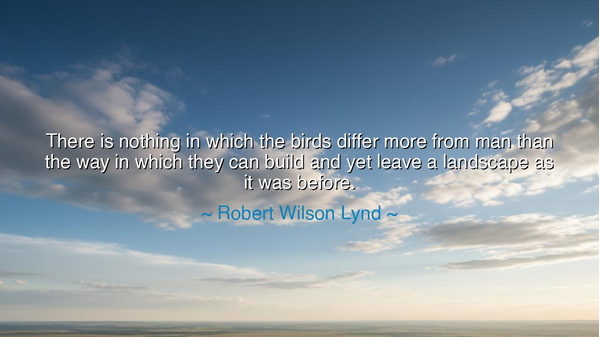
There is nothing in which the birds differ more from man than
There is nothing in which the birds differ more from man than the way in which they can build and yet leave a landscape as it was before.






Robert Wilson Lynd once observed: “There is nothing in which the birds differ more from man than the way in which they can build and yet leave a landscape as it was before.” These words, gentle yet piercing, remind us of the contrast between human ambition and the quiet harmony of nature. The bird, small and fragile, builds its nest with care, weaving twigs and grass, and when it departs, the meadow or forest remains as whole as before. Man, however, builds cities, towers, and roads—and in so doing reshapes the earth, often leaving scars where beauty once dwelt. In this simple truth lies a profound lesson: that creation need not always conquer, but may coexist with grace.
The origin of this wisdom is found in Lynd’s reflections on the natural world. As an essayist, he often turned his gaze to the ordinary wonders of life—flowers, seasons, and the creatures of the sky. From such observations he drew out truths that touched the human heart. To him, the birds were not just singers of dawn, but teachers of balance. They showed that it was possible to create shelter, to nurture life, and yet to do so without disturbing the harmony of the greater landscape. His words are not condemnation, but invitation: to learn from the bird’s quiet art.
The ancients, too, saw wisdom in the ways of animals. The Proverbs speak of the ant who labors with foresight, the eagle who soars with strength, the sparrow whose fall does not escape the eye of heaven. In each creature, a lesson for humankind. Here, in the art of the bird’s nest, we find perhaps the greatest lesson: that to live well is not to dominate the earth, but to dwell within it, shaping without destroying, building without defacing. For the bird, unlike man, does not seek to conquer the forest; it seeks only to belong within it.
Consider the story of the Iroquois and their “Great Law of Peace.” Their way of life taught that every decision must be made with regard for the seventh generation to come. When they built, they sought to live in balance with streams, trees, and fields. Their longhouses rose in harmony with the land, unlike the sprawling empires that paved and cut down without restraint. Like the birds, they believed that true greatness lay not in altering the landscape forever, but in leaving it whole for those yet unborn. Their wisdom stands as a rebuke to the restless appetite of man and an echo of Lynd’s insight.
The meaning of this quote strikes deeply at the heart of modern life. Man’s building has brought wonders—bridges across seas, towers that touch the heavens, machines that shrink distances. Yet too often, these wonders leave behind ruin: forests cut down, rivers poisoned, skies darkened. Lynd reminds us that the birds, without wealth or tools, achieve their purpose without wounding the earth. Their simplicity shames our excess. Their balance shows the folly of our greed.
The lesson for us is plain: we must learn again the art of building with humility. To create, not as conquerors, but as participants in the great harmony of life. Our homes, our cities, our works—these should rise with reverence for the landscape, leaving beauty intact rather than destroyed. This calls for restraint, for wisdom, for the courage to build not for pride but for necessity, and to let the world remain whole even after we have shaped it.
In your own life, practice this wisdom by walking gently upon the earth. When you build, plant also. When you take, give back. Let your presence leave not scars, but blessings. Study the birds—their nests are sufficient, their songs enrich the air, and when they depart, the forest remains as it was. So too should our lives be: creative, fruitful, yet leaving the world no poorer for our passing.
Therefore, remember Robert Wilson Lynd’s words: “There is nothing in which the birds differ more from man than the way in which they can build and yet leave a landscape as it was before.” May we not only admire the nests of the birds, but learn from them. For in their fragile art is hidden the strength of true wisdom: to build without destroying, to dwell without scarring, and to live in harmony with the eternal beauty of the earth.






AAdministratorAdministrator
Welcome, honored guests. Please leave a comment, we will respond soon